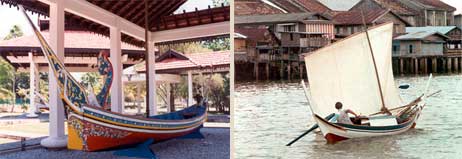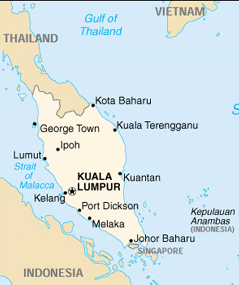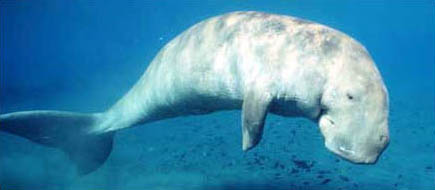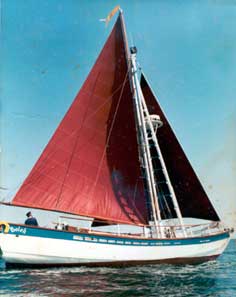The tradition of building wooden boats in modern Malaysia reaches far back in time: For overseas-trade, for fishing, for piracy, for travelling up the many rivers, for each purpose they developed a special design.

typical
Terengganu boats (see also PHOTO COLLECTION,
traditional
craft)
With Malacca becoming the main trading centre for the spices arriving from the Molucca islands (Indonesia), the Malay Peninsula turned into a melting pot of the seafaring, trading civilisations: Indians and Chinese, Arabs and Indonesians, Vietnamese and Thai, Burmese, Europeans and others, they all arrived in their distinctive craft, inspiring the Malay shipbuilding.
On the east coast of the peninsula, where the river Terengganu meets the sea, lies a small island, right in the rivermouth.
Old tales tell the story of a mermaid, an indo-pacific seacow (scientific: Dugong Dugon, order: Sireniae) one day sitting on the eastern shore of this island. Thus the name stuck: Pulau Duyong (pulau = Malay: island). Some say that in former times the Sultan of Terengganu gave this island to the Bugis, a seafaring people from Celebes (Sulawesi, Indonesia), to establish a free port. He meant to enhance the trade on the east coast of the peninsula since the Bugis are well known throughout SE-Asia as traders, boat builders and fierce pirates. They settled and stayed and it was here that the finest boatbuilding of Malaya should develop.

In the 19th century a French captain is said to have marvelled at the sight of the fleet of ships from all corners of the globe, anchored in the estuary: Arab dhaus, perahus Portuguese lorcas, English schooners, Chinese, Vietnamese and Thai junks, a great flotilla of trading vessels was assembled here, in the harbour off Duyong island: the pride of the Sultan of Terengganu, laden with the riches of his country.

"mermaid":
Dugong Dugon
The two "perahu besar" (Malay: big ships) of Terengganu, the PINIS and the BEDAR are the result of this cultural interchange. In its name, the Pinis already betrays the French influence (French: pinasse) while the Bedar shows Arab/Indian (dhau) elements. Jib and bowsprit of the two are of western origin, with junks almost never carrying one. The sails of both of them are that of a classic Chinese junk: The rigging with the elaborate sheet system, the parrels, the snotter and the lazyjack-system, all are documented in Chinese literature for over 2000 years!
Far beyond the South China Sea they were famous as the junk hybrids they truly are. Malay ingenuity, driven by desire for the ever faster and more manoeuvrable vessel, combined the positive elements and created these picturesque sailing ships.
The boatbuilders of Terengganu were re-“discovered” during the 2nd world war by the Japanese navy. According to the late Hadschi Ali bin Ngah, a well known Duyong shipwright “they chopped some heads...” and forced the craftsmen and fishing folks of Terengganu to build wooden minesweepers.
When the war was over, Commander R. A. Kilroy, DSC RN, an English officer stationed in Singapore employed two young craftsmen (one of them the young Che Ali) to come down and build his BOLEH (Malay: can do), a vessel of his own design, which he sailed to England later and which I met in the Med in 1986. He wrote the book “Boleh” about his adventures.

"BOLEH", 1986 in the Meditteranean
Sea
Since the 60ies, "orang putih" (Malay: white people), “westerners”, kept coming from France and Britain, Australia and New Zealand, America and Germany to have their “dreamboat” built in Duyong: Some of them chose the traditional junk design of a Pinis or a Bedar, while others brought the plans of European/American boats to have them built. When I first arrived there in the late 70ies, these traditional vessels were still operating and anchored in the harbour of Kuala Terengganu (kuala = Malay: rivermouth), from where they sailed up to Thailand to load salt and other goods.
Since hat time the Malays have stopped building sailing boats for their own use, but they kept manufacturing fishtrawlers and ferries, built using the old techniques. Rising timber prices and diminishing resources of fish forced one after the other yard out of business, so today there are only 5 yards operating, where hundreds of people earned their “rice” just 20 years ago.
To
foster the ancient art of the Malay wooden shipbuilding is one purpose
of this project
NAGA
PELANGI II
(Rainbow Dragon)
This
important element of the Malay cultural heritage
must not die!
Sailing the Naga
Pelangi,
a 45’ (LOD) Bedar, built for me in 1980 by Che Ali bin Ngah and
his sons Hassan, Yussup and Ariffin in Duyong, I learned how truly seaworthy
these magnificently crafted vessels are: During my circumnavigation,
Naga Pelangi gracefully rode the waves, hove to, with hurricane Anna
developing near Palau
in
the western Pacific (January '97)!
We wish to inspire the Malay youth to pick up the crafts of their fathers and hope to show the superior quality of this archaic art of building wooden vessels.
We wish to make the sailing of these picturesque junks, that once were such a familiar sight in SE-Asian waters, popular again amongst the people of Malaysia: the paradise bays and the unspoiled reefs of islands like Kapas, Redang, Perhentian and many others lie right on the “doorstep” of Kuala Terengganu, waiting to be explored.

Junk
sailing:
The Bedar
"SETIA", around the middle of last century in the South
China Sea